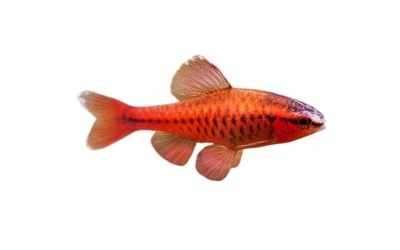The cherry barb is an exceptionally famous and appealing fish among the freshwater aquarium devotees because of its splendid tinge. It is a freshwater ray finned cyprinid of order Cypriniformes. At present, this gorgeous fish is listed as threatened species on the IUCN Red List due to over exploitation and pollution.
Systematic Position
Distribution and Habitat
It is an endemic to Sri Lanka where it is found in streams and waterways. It wants to live in shaded regions where moderate moving shallow waters with bottom sediment and leaf litters are available.
Common Names
It is additionally called Red Cherry barb, Crimson Carplet etc.
Body Shape and Colors
It is an appealing addition to any pet fish keepers because of their dazzling body shape and shading. The body is prolonged and torpedo shaped with little terminal mouth. Back is darker with light greenish sheen. Flank and belly have brilliant features. A dark colored or blue-dark longitudinal stripe is seen which begins from the tip of the nose and finishes at the base of the caudal fin.

Size and Lifespan
The cherry barb is an exceptional community fish. It can grow up to 6 cm long and can live up to 8 years or more if it is taken proper care.
Quick Cherry Barb Facts
Food and Feeding Behavior
It is omnivorous fish and its eating routine comprises of plant materials like algae, diatoms and organic debris. It also takes insects, larvae/hatchlings, and different zooplankton like Cyclops, Daphnia, Moina and so on. In aquarium condition, it effectively accepts live and frozen foods, for example, Chironomous larvae, Daphnia, Brine shrimp with flake foods. The feed should be given 2-3 times every day to keep your fish glad and healthy.
Housing and Care Facts
It is a social fish with quiet in nature. It needs no less than 10 gallon tanks or bigger is prescribed. The tank should have open space for swimming with floating plants for hiding spots. The tank should have great water quality with effective filtration system and water movement. To keep our tank condition sound, 20-25% water must be changed in every other week.
Tank-mates
It is a schooling fish and it should be kept in groups with at least six individuals. Appropriate tank-mates incorporate tetras, rainbowfishes, livebearers, catfishes, loaches, Gold Barb and anabantoids and so forth.
Male and Female Sex Differences
At the adolescent stages, it is difficult to make sex separation. For the most part, the male is redder and slimmer however the female is lighter in shading. During spawning season, the male turns out to be dark red yet the female shows lighter red in shading with yellowish fins. The female also has red gills than the male.
Breeding Behavior
The red cherry is an egg spawner. It can easily produce eggs in hostage condition if appropriate care is taken. The rearing tanks should have vegetation with bunch of java moss. The mature female lays up to 300 eggs on plant or substrate surface.
The eggs incubate within 24 hours and the fry turn out to be free swimming within 2-3 days after hatching. The infant fish should be fed with infusoria and recently incubated Artemia (Brine shrimp). For ideal development for your infant cherry barb, feed should be given no less than three times daily.
Diseases and Preventive Measures
Cherry Barb is a hardy fish however in some cases it is defenseless to itch because of wrong upkeep of water quality and improper maintain of tank environment. In this case, you should take great care for your tank environment and provide balanced diet to prevent diseases.
Also Read: Best Protein Skimmer – Reviews and Comparison Guide
Concluding Remarks
All things considered, it is an exceptionally popular and alluring fish among the pet fish guardians because of its appealing body shape and splendid hue. If you retain this attractive fish in your fish tank it gives an extra mental fulfillment to any or every member of your family. But if you are still looking for something else please read Bronze Corydoras Fish Info.
